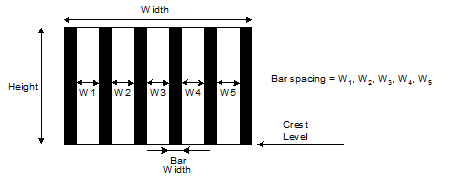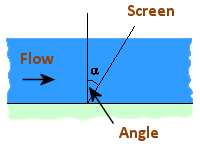Screen Data Fields
InfoWorks ICM allows the modelling of sloping bar screens in the network. A screen is used to trap debris in the network, possibly at the entrance to a treatment works.
The calculation method uses the Kirschmer formula, which is appropriate for clean screens. For screens that are partially blocked it may be more appropriate to use a User-Defined Control and define a Head Discharge Table to represent the screen.
Screen data can be edited on either the Screen Grid Window of the Links Grid or the Screen Property Sheet.
To view and edit all screen data, use the Property Sheet.
This table describes all the screen specific data which can be used to define a screen. For details of results fields, see the Link Results Data Fields topic.
 Common Data Fields
Common Data Fields Fields that are common to the majority of objects can be found in the Common Fields topic.
Screen Data
Database Table Name: hw_screen
|
Field Name |
Help Text |
Database Field |
Size |
Precision |
Default |
Error Lower Limit |
Error Upper Limit |
Warning Lower Limit |
Warning Upper Limit | |||||||||||||||||||||||
|---|---|---|---|---|---|---|---|---|---|---|---|---|---|---|---|---|---|---|---|---|---|---|---|---|---|---|---|---|---|---|---|---|
|
Crest |
Crest Level is the level above datum of the base of the screen.
|
crest |
Double |
|
Z |
3 |
|
-9999 |
9999 |
|
6000 |
|||||||||||||||||||||
|
Width |
The total width of the screen, including bars and bar spaces. |
width |
Double |
|
L |
3 |
|
0 |
|
|
|
|||||||||||||||||||||
|
Height |
The total height of the screen. |
height |
Double |
|
L |
3 |
|
0 |
|
|
|
|||||||||||||||||||||
|
Angle |
InfoWorks ICM assumes that screens are either vertical or leaning forward in the direction of flow. There is no support for negative angles. |
angle |
Double |
|
ANGLE |
2 |
0 |
0 |
89 |
|
|
|||||||||||||||||||||
|
Kirschmer's shape factor |
InfoWorks ICM uses the Kirschmer formula to calculate the head difference through the screen. See Screens. Typical values for the Kirschmer coefficient are:
|
kirschmer |
Double |
|
|
2 |
1.79 |
0.01 |
|
|
|
|||||||||||||||||||||
|
Bar width |
The thickness of the bars making up the screen. |
bar_width |
Double |
|
PS |
1 |
|
0.000001 |
|
|
|
|||||||||||||||||||||
|
Bar spacing |
The width of the clear gap between the bars. This is NOT the distance between the centre of the bars. |
bar_spacing |
Double |
|
PS |
1 |
|
0.000001 |
|
|
|
|||||||||||||||||||||
|
US node ID |
Type in a node reference or choose an existing node reference from the dropdown list. This makes up the first part of the link reference. |
us_node_id |
Text |
64 |
|
0 |
|
|
|
|
|
|||||||||||||||||||||
|
Link suffix |
A single character between A and Z or 0 and 9 which completes the link reference. This allows a node to have up to 36 downstream links. The suffix is automatically allocated by the software. |
link_suffix |
Text |
1 |
|
0 |
1 |
|
|
|
|
|||||||||||||||||||||
|
DS node ID |
Type in a node reference, or choose an existing node reference from the dropdown list. |
ds_node_id |
Text |
64 |
|
0 |
|
|
|
|
|
|||||||||||||||||||||
|
Link type |
There are no additional options. The field is hidden on the grid, and read-only on the property sheet. |
link_type |
Text |
6 |
|
0 |
SCREEN |
|
|
|
|
|||||||||||||||||||||
|
System type |
Choose the system type from the dropdown list. See System Type for more information.
|
system_type |
Text |
10 |
|
0 |
Other |
|
|
|
|
|||||||||||||||||||||
|
Asset ID |
For reference only. Designed as a reference to an asset database, but could be used for anything. |
asset_id |
Text |
64 |
|
0 |
|
|
|
|
|
|||||||||||||||||||||
|
Sewer Reference |
An optional reference to identify the sewer of which this conduit is a part. |
sewer_reference |
Text |
80 |
|
0 |
|
|
|
|
|
|||||||||||||||||||||
|
Points |
This field defines the geometry of the link. The underlying data consists of a series of (x,y) pairs defining the vertices of the link. Each link is made up of a series of straight lines between the defined (x,y) points. This data is not displayed on the grid or property sheet.  Link Vertice Export Link Vertice Export
Link vertices are included when you export link data to CSV files. There are two options available for exporting link vertices. These are selected on the Select CSV Export Options Dialog using the Coordinate Arrays Format dropdown list. The options are:
|
point_array |
Array |
|
XY |
0 |
|
|
|
|
|
|||||||||||||||||||||
|
DS settlement efficiency (%) |
See US settlement efficiency. |
ds_settlement_eff |
Long Integer |
|
|
0 |
0 |
0 |
100 |
|
|
|||||||||||||||||||||
|
US settlement efficiency (%) |
The settlement efficiency fields allow you to set the effectiveness of an overflow for trapping out sediment. The overflow is a link (normally a pipe) attached to a node acting as a storage tank (storage node or manhole). Normally the upstream end of the link will be attached to the node and act as the overflow. The upstream settlement efficiency determines the efficiency for the overflow. In some circumstances the link may be reversed (storage tank at the downstream end) and the downstream settlement efficiency will be used. In many cases an overflow will attach to an outfall from the system. It would be very unusual to have both upstream settlement efficiency and downstream settlement efficiency set to non-zero values. The valid range is 0-100%. 0% means the overflow acts as a normal continuation link. 100% means that the overflow traps out as much sediment as possible. |
us_settlement_eff |
Long Integer |
|
|
0 |
0 |
0 |
100 |
|
|
|||||||||||||||||||||
|
Branch ID |
Numeric field used to identify to which long section the link is associated. Can be set manually or automatically (see Defining Branches topic for more information). |
branch_id |
Long Integer |
|
|
0 |
|
0 |
|
|
|
|||||||||||||||||||||
|
InfoAsset unique ID |
Unique ID associated with the corresponding object in an InfoAsset Manager database. When importing from InfoAsset Manager, the InfoAsset ID can be copied from the InfoAsset database in order to maintain links between the two networks. |
asset_uid |
GUID |
|
|
0 |
|
0 |
0 |
0 |
0 |
|||||||||||||||||||||
| InfoAsset ID |
Used to store the ID of the corresponding InfoAsset object when Importing from a Collection Network. |
infonet_id | Text | 40 | 0 |

 The angle of the screen measured in degrees from the vertical axis. Therefore a vertical screen has an angle of zero degrees.
The angle of the screen measured in degrees from the vertical axis. Therefore a vertical screen has an angle of zero degrees.
 Water Quality
Water Quality
